The versatility of vining perennials is immense. Climbing plants add layers of vertical interest to the landscape. They fill empty spaces with splendor, adding texture and stature to the garden and landscape in exciting and dramatic ways. Vining perennials need a bit more planning than other landscape plants, but the effort is absolutely worth it for the sensational results.
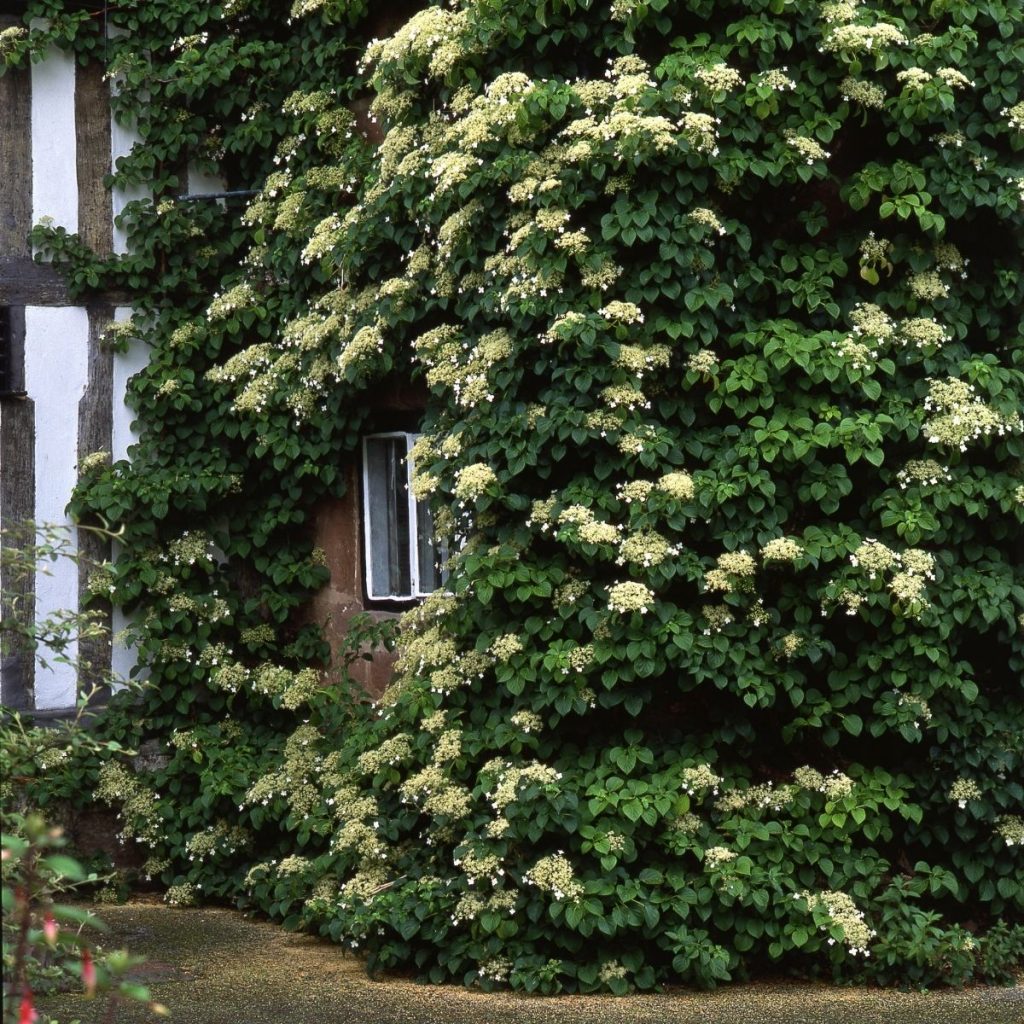
How To Incorporate Climbing Perennials Into The Garden
These perennials want to climb, so it is essential to provide them adequate means to follow their nature. This varies by plant; some flowering perennials need super strong supports while others barely need any additional help to scale upwards. To be the most successful, you need to evaluate the climber's needs before planting and make sure you give it the best beginning.
- Look around your landscape. There may already be fantastic locations where a vining perennial will fit. Think creatively.
- If you don't have any (or enough!) climbing spaces already available, install an arbor, trellis, or decorative fencing for the vining flower.
- Vining perennials make excellent (and beautiful!) screens or privacy fences.
- Most climbers are also highly fragrant. Plant them in a location where you'll be able to enjoy their wonderful scents fully.
- Perennial climbers take a few seasons to establish, so be patient and plan ahead.
- Always install the trellis or climbing structure before planting, so you don't disturb the roots later on.
A Note Before Planting
The majority of perennial vines are vigorous growers. This is a great thing when you want to improve and expand your landscape, but it does come with a significant downside. If you're not careful or attentive, these vines can run over or escape their original location and become problematic. This isn't a big deal in many instances, but non-native vines escaped from cultivation have completely changed our natural landscape over the years and centuries.
Be aware, very aware, of what you are planting before you start, including knowing whether it is native or non-native and its particular growth habit. This warning isn't meant to scare you or deter you from planting non-native vines, just to be mindful.
There are many fabulous non-natives perennials that aren't problematic and don't need to be avoided. The key is to be knowledgeable beforehand so you aren't surprised and so we can preserve our natural landscape for the native wildlife, insects, and plants.
Non-native Planting Tip: Nearly all vining perennial flowers have a small stem base and root system. Plant the vine in a large pot instead of in the ground and place it near the spot where you want it to climb. It will still stretch out and vine up the desired structure, and it is less likely to spread since its root system is contained.
To further reduce potentially invasive issues, remove all seed pods from the plants before they open and spread.
10 Top Climbing Perennials
Dutchman's Pipe (Aristolochia macrophylla)

Featuring intriguing and unusual pipe-shaped flowers, this native perennial climber creates a stunning vertical display. Dutchman's Pipe vines grow 15-30 feet long and loves to twine around arbors and up garden walls. The leaves are deep green and huge, up to 12 inches long, and heart-shaped. Even though the flowers are curious and enchanting, Dutchman's Pipe is often grown just for the interesting foliage.
Dutchman's Pipe is one of the primary food sources for the Pipevine Swallowtail Butterfly; if for no other reason, plant it for these important pollinators. A favorite classic climbing vine, Dutchman's Pipe creates a lively and beautiful screen with its massive leaves and distinctive flowers.
- Hardy to zones 5-8
- Full sun or partial shade
- Native to the eastern United States
Passion Flower (Passiflora)
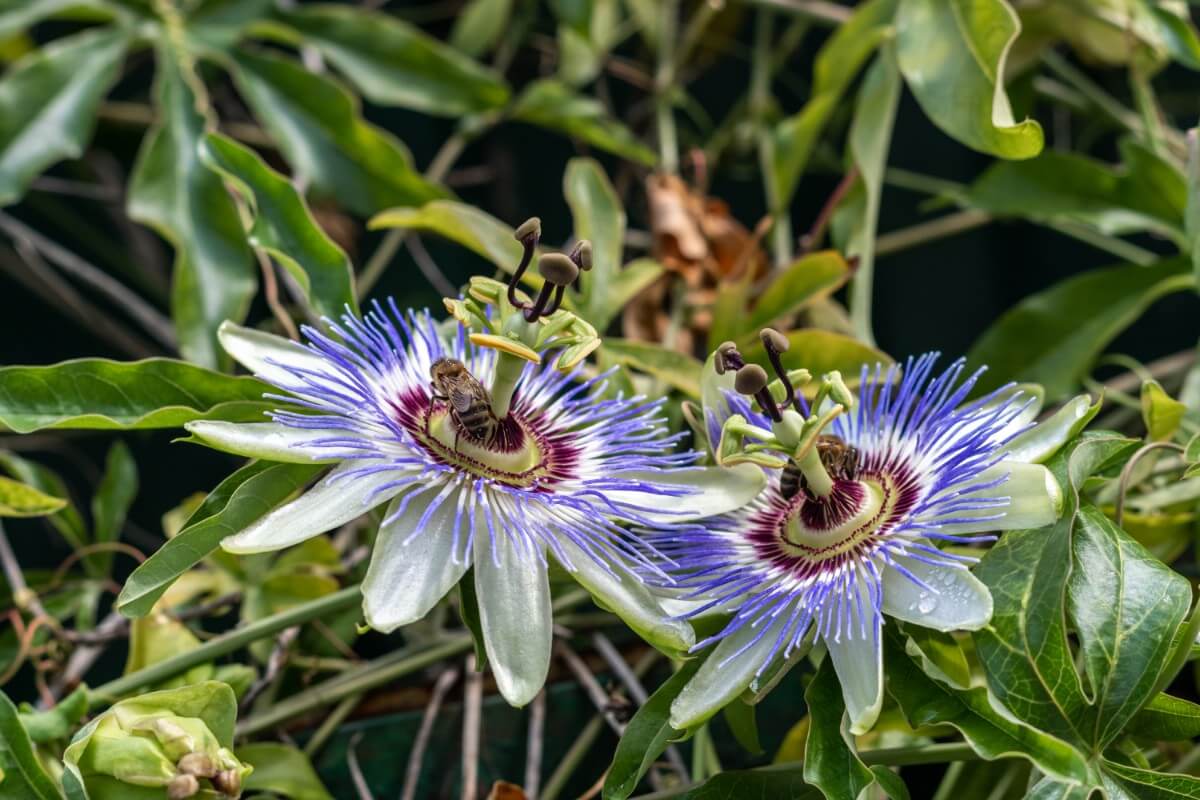
The intricate and extraordinary flowers of the Passion Flower vine will light up any space you plant this climbing vine. Passion Flowers are impossible to describe; they look other-worldly and will add a definitive tropical vibe to your garden. There are lots of options when it comes to Passion Flowers. There are several native and non-native species, as well as plentiful cultivars and hybrids.
Because Passion Flowers are an essential food source for pollinators as well as being a larval host for native butterflies, we advise planting native species whenever possible. Passion Flower is a hardy and vigorous climber with a sweet, enticing fragrance and is ideal for trellises, porch sidings, fences, and arbors.
- Hardy to zones 5-11, depending on species
- Full sun or partial shade
- Wild Passion Flower (Passiflora incarnata) – a native southeastern wildflower with vibrant 3-inch wide purple flowers and grows 6-8 feet long. Host to Gulf Fritillary, Variegated Fritillary, Mexican Fritillary, Zebra Longwing, and Julia butterflies. Zones 6-11.
- Yellow Passion Flower (Passiflora lutea) – a native eastern and south-central wildflower with muted, small 1-inch wide, highly fragrant flowers. Averages 10-20 feet long. Host to Zebra Longwing, Julia, and Gulf Fritillary (Passion) butterflies. Zones 5-10.
Trumpet Vine (Campsis radicans)
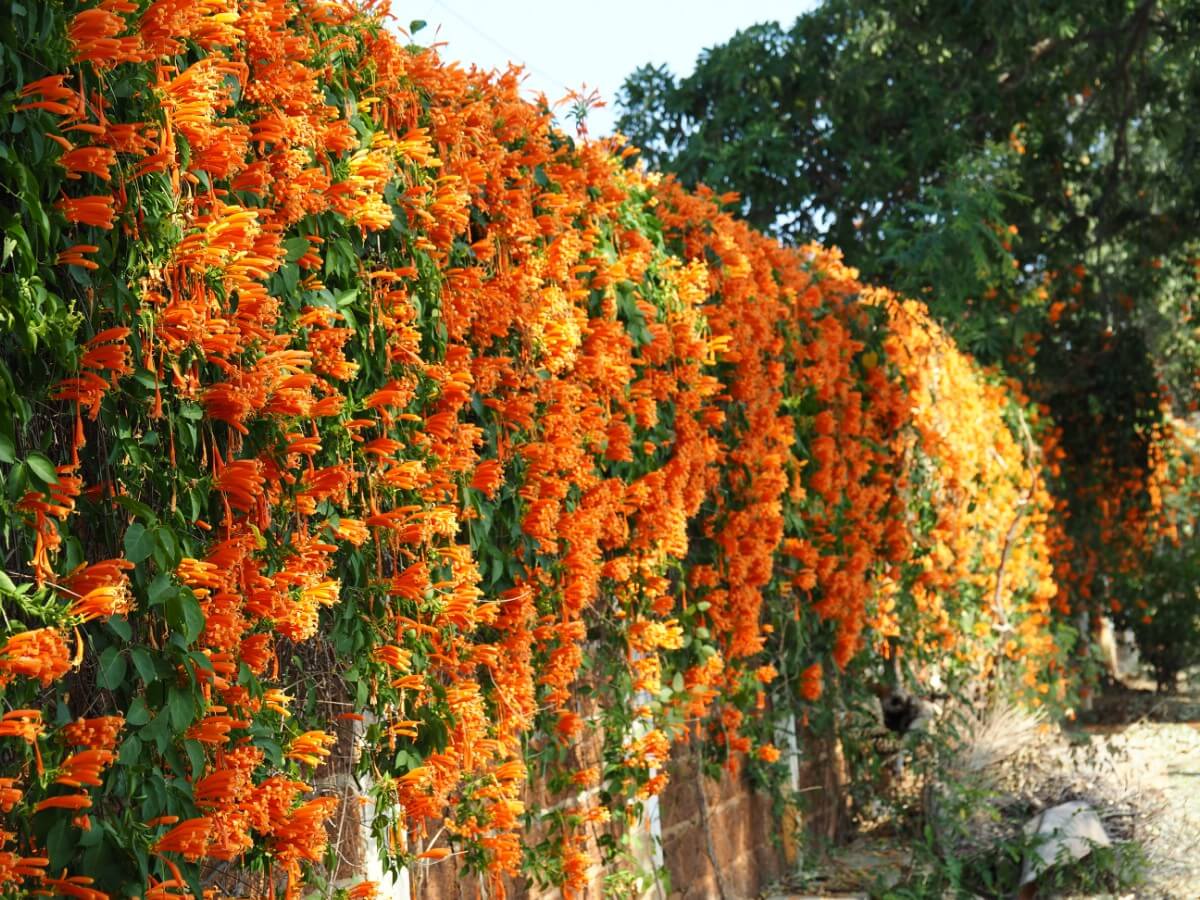
This showy hummingbird magnet is an aggressive native plant that is worth planting but also needs to be kept tabs on. If left to its own devices, the Trumpet Vine will take over your entire yard. And, while the hummingbirds would be thrilled, you might not be so much. The gorgeous orange and red multicolored tubular flowers are sweetly fragrant and add rich appeal to the garden.
Be sure to plant this one in a pot and never directly into the garden. Trumpet Vine is an ultra-fast climber, quickly reaching 30-40 feet, and will scramble up anything in its path. Like ivy, it uses aerial rootlets to climb, which damages wood, stone, and brick. A dedicated arbor or trellis is best for this native vine.
It is becoming more common that people suggest planting the non-native Chinese Trumpet Vine (C. grandiflora) because it is not quite as aggressive. However, this is a bit of a misnomer. Chinese Trumpet Vine isn't "as" aggressive, yet it is still a super-fast grower that will take over whatever space it is in. Treat it the same as the native; plant it in a pot, never in the ground, and keep an eagle eye on growth!
- Hardy to zones 5-9
- Full sun or partial shade
- Drought, heat, poor soil, and cold tolerant
Climbing Hydrangea (Hydrangea anomala sub petiolaris)
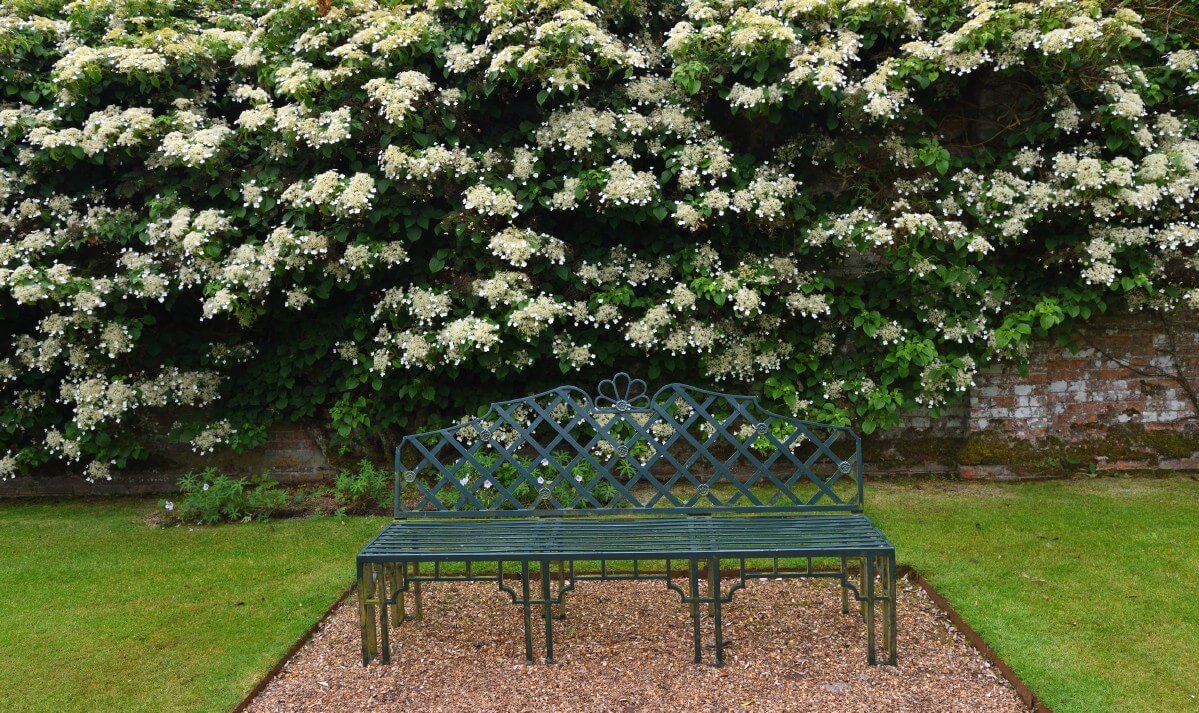
An elegant late spring bloomer, Climbing Hydrangea is the perfect solution for unsightly fences, blocking nosy neighbors, and shielding yards. This climbing perennial loves full shade, which is rare among vining plants. Climbing Hydrangea foliage is prolific with large heart-shaped dark-green leaves which turn golden-yellow in autumn.
The blooms are flattened dense clusters of snowy-white flowers which appear in masses from spring through early summer. Climbing Hydrangea vines grow 30-40 feet long and 5-6 feet wide. If left unsupported, the vine turns into a sprawling, wide shrub.
- Hardy to zones 4-9
- Full or partial shade
Trumpet Honeysuckle (Lonicera sempervirens)
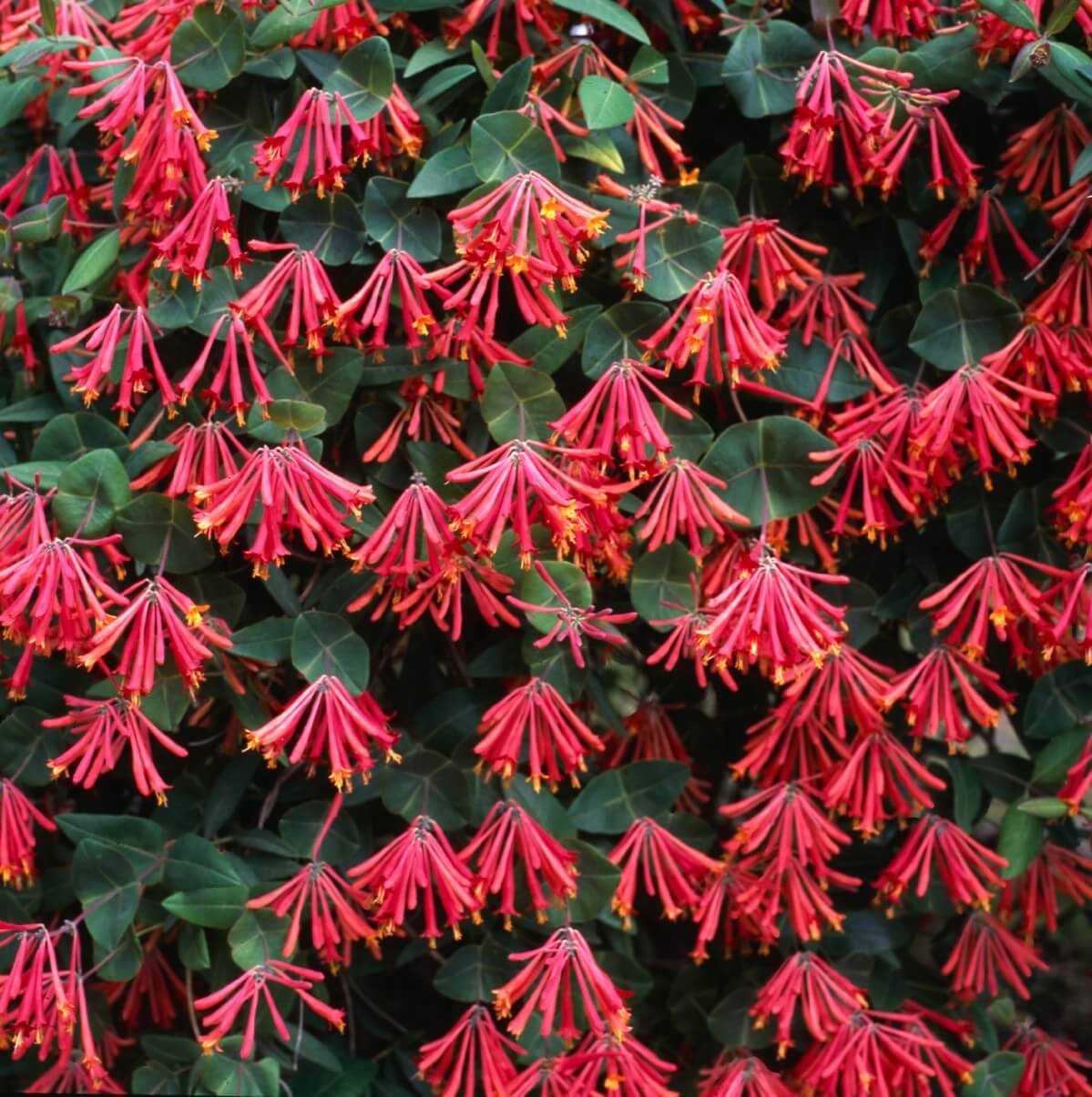
When you want to bring all the hummingbirds and butterflies to the garden, plant native Trumpet Honeysuckle! The dense clusters of scarlet red tubular flowers with bright yellow throats are irresistible to pollinators and people alike. Combined with attractive blue-green glossy foliage and a cheerful climbing habit, Trumpet Honeysuckle stands out in the landscape.
This perennial vine grows 8-15 feet tall and is especially captivating winding up an arbor or spreading across a pergola. This native Trumpet Honeysuckle isn't fragrant like other honeysuckles, but don't let that dissuade you; it doesn't need to emit a perfume to be perfect.
Notes on Honeysuckles: Non-native honeysuckles, like the Japanese, Chinese, and Dutch species, are invasive and problematic, with long systemic effects on the native landscape. Please do not plant these, not even in containers. They have escaped cultivation so many times it is now a rampant issue across the country.
- Hardy to zones 4-9
- Full sun
- Native to the Midwest, New England, and the southern United States
- In addition to this native Trumpet Honeysuckle, there is Pink Honeysuckle (L.hispidula) and Orange Honeysuckle (L.ciliosa), which are native to the Pacific Northwest.
Cross Vine (Bignonia capreolata)
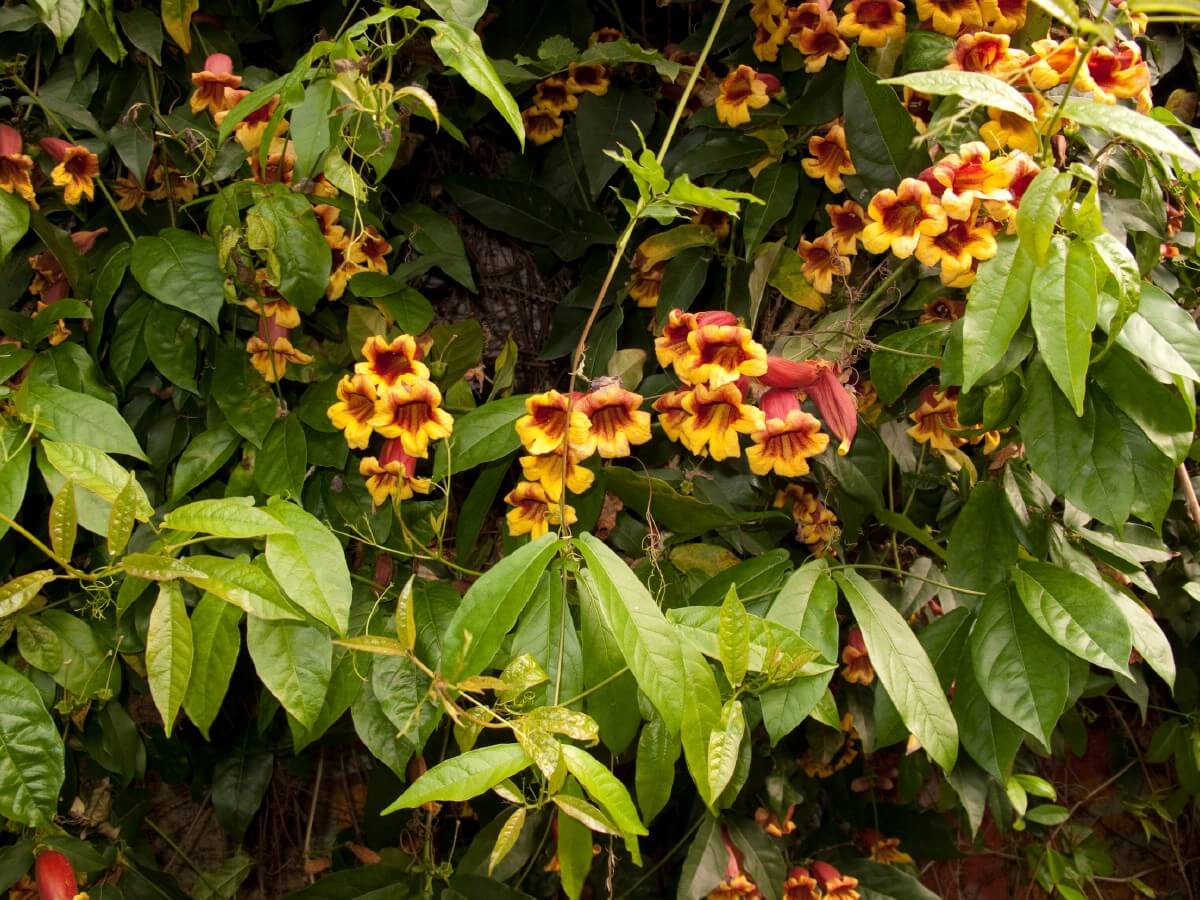
In spring, this fast-growing native perennial vine is absolutely covered in clusters of orange, red, and yellow trumpet-shaped flowers. Cross Vine isn't shy and will spread 30-40 feet, covering everything in its path with attractive dark green glossy leaves. The delightful, colorful blooms last for weeks, and the hummingbirds will flock to them. Keep this one in a pot and keep an eye on it. Even though it is native, it will try to sneak to places you don't want it. Cross Vine is especially useful in covering unsightly buildings, fences, and arbors.
- Hardy to zones 6-9
- Full sun or partial shade
- Deer resistant
- Native to the southern United States
American Wisteria (Wisteria frutescens)
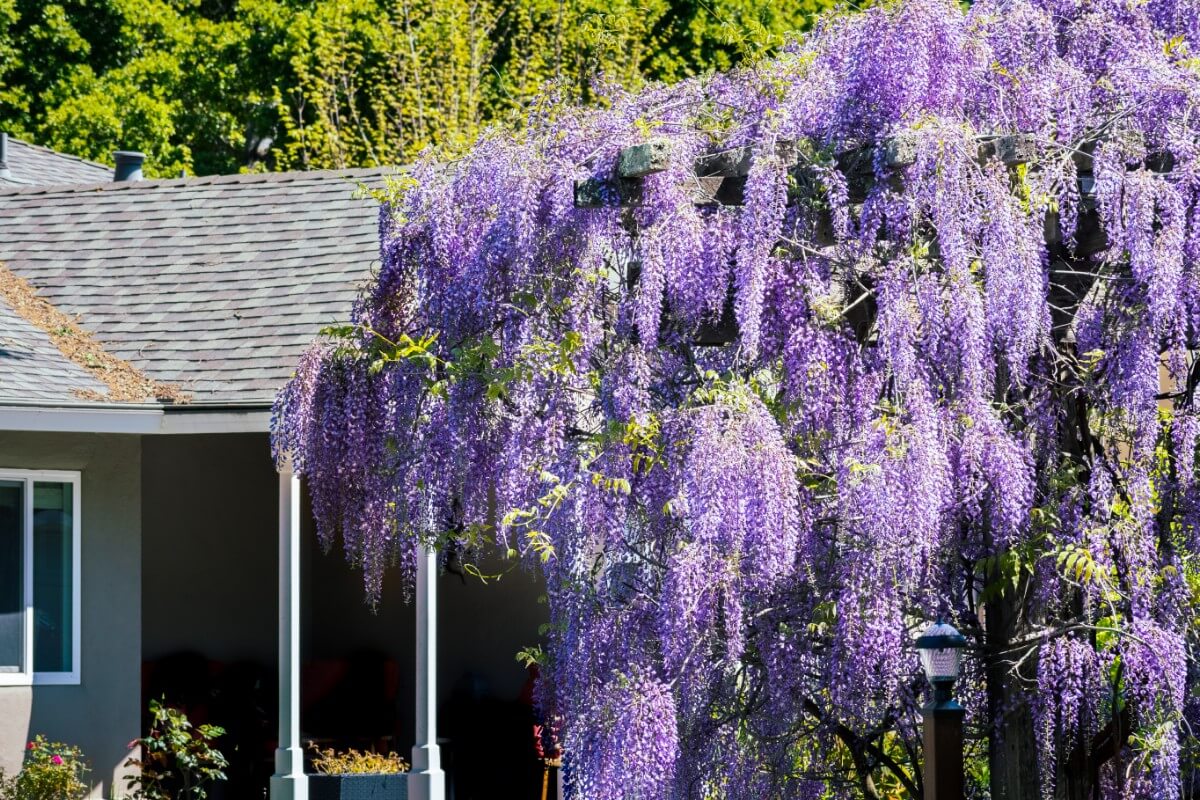
Beautiful and fragrant, American Wisteria is spectacular for porch columns, walls, pergolas, and fences. This incredible native perennial climber produces prolific clusters of drooping purple flowers. The foliage is glossy, dark-green, and sparse, letting the blooms be the star of the show.
American Wisteria is a twining vine and will twist itself around and up posts, pillars, and poles. It easily reaches 15-30 feet and, at full height, is quite heavy, so be sure it has a solid structure to support it. Plant American Wisteria where you can enjoy the sweet fragrance.
As with so many other climbing perennials, there are also non-native Wisterias that are popular landscape choices. Unfortunately, the non-natives grow quite aggressively and are listed as invasive in many areas. Please only plant the natives American Wisteria and Kentucky Wisteria (W.macrostachya).
- Hardy to zones 5-9 (Kentucky Wisteria is hardy to zones 3 and up)
- Full sun
- Native to the eastern United States
Clematis (Clematis)
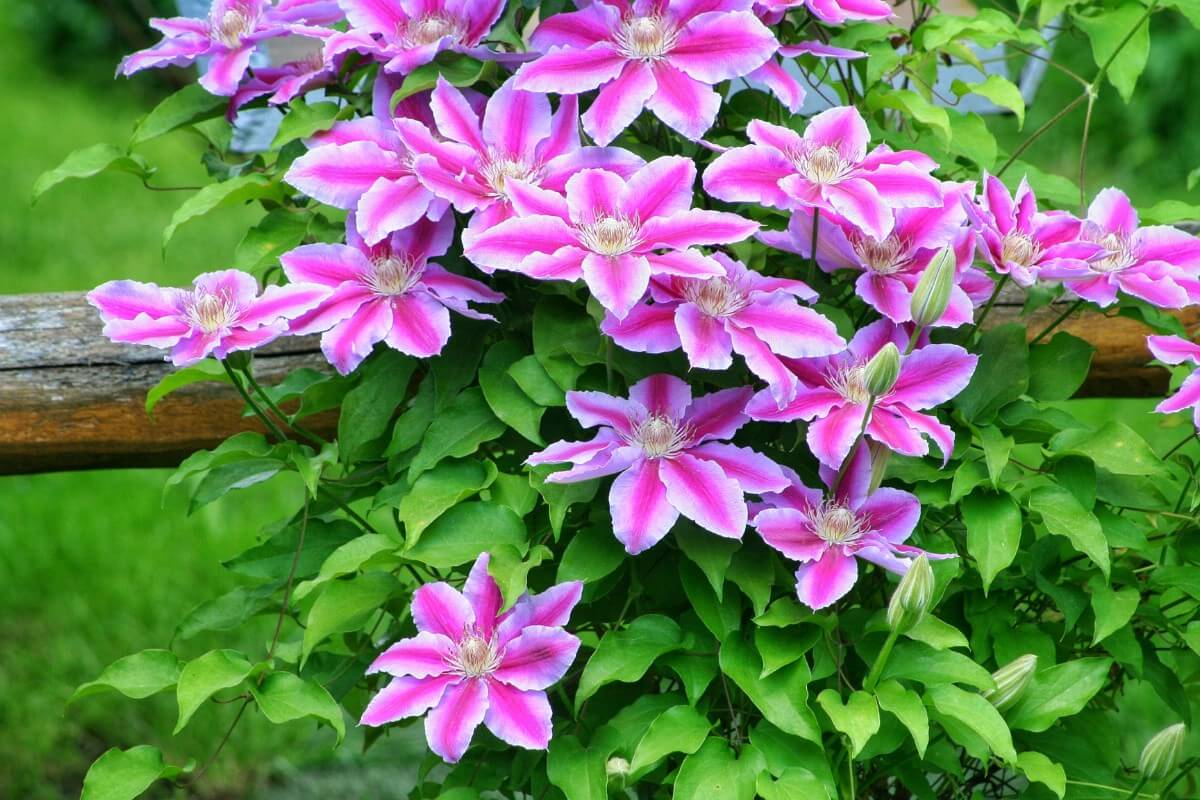
The quintessential vining flower, Clematis is a much beloved and long utilized landscape plant. Clematis flowers are visual stunners, putting on a spectacular show when in full bloom; they are most known for how long they flower compared to other flowers. The flowers are huge, star or bell-shaped, and brilliantly colored. In addition to being treasures in the landscape, Clematis are a great choice because there are seemingly endless varieties to choose from. Clematis are organized by flowering season, with early-season and late-season cultivars.
These hardy perennial climbers are short-growers in the world of vining plants, usually averaging between 3-10 feet. This makes them ideal for smaller spaces, trellises, and even containers. You don't have to worry about supporting a heavy vine or preventing it from taking over your fence. Some species are fragrant, but not all of them give off perfume.
In addition to hybrids and cultivars, there are several native Clematis flowers. These aren't as showy or stunning, but each is wonderful in its own right and is ideal for a native garden as they add infinite charm to any space they occupy. Clematis is hardy to zones 4-9, depending on species, and likes to have its roots in the shade and foliage in the sun.
Native Clematis species:
Rock Clematis (C.columbiana) – native to the midwest and northwest, Rock Clematis has nodding bell-shaped lavender-blue flowers and grows 10-12 feet long.
Virgin's Bower (C.virginiana) – native to the midwest, northeast, and southeast, Virgin's Bower is an aggressive spreader that quickly reaches 10-20 feet. It produces massive amounts of sweet-smelling snow-white flowers.
Scarlet Clematis (C.texensis) – native to Texas, Scarlet Clematis features loads of small deep red flowers and grows 10-15 feet long.
Leatherflower (C.viorna and C.pitcheri) – a native of the midwest and northeast, Leatherflower boasts small lavender downward-facing tulip-shaped blooms and grows 8-12 feet long.
Blue Jasmine (C.crispa) – a native of the midwest and southeast, Blue Jasmine features masses of lightly fragranced pale blue nodding bell-shaped flowers and grows 6-10 feet long.
Western White Clematis (C.ligusticifolia) – native to much of the western US, Western White Clematis produces prolific small white showy flowers and grows 3-30 feet long.
Variegated Kiwi Vine (Actinidia kolomikta)
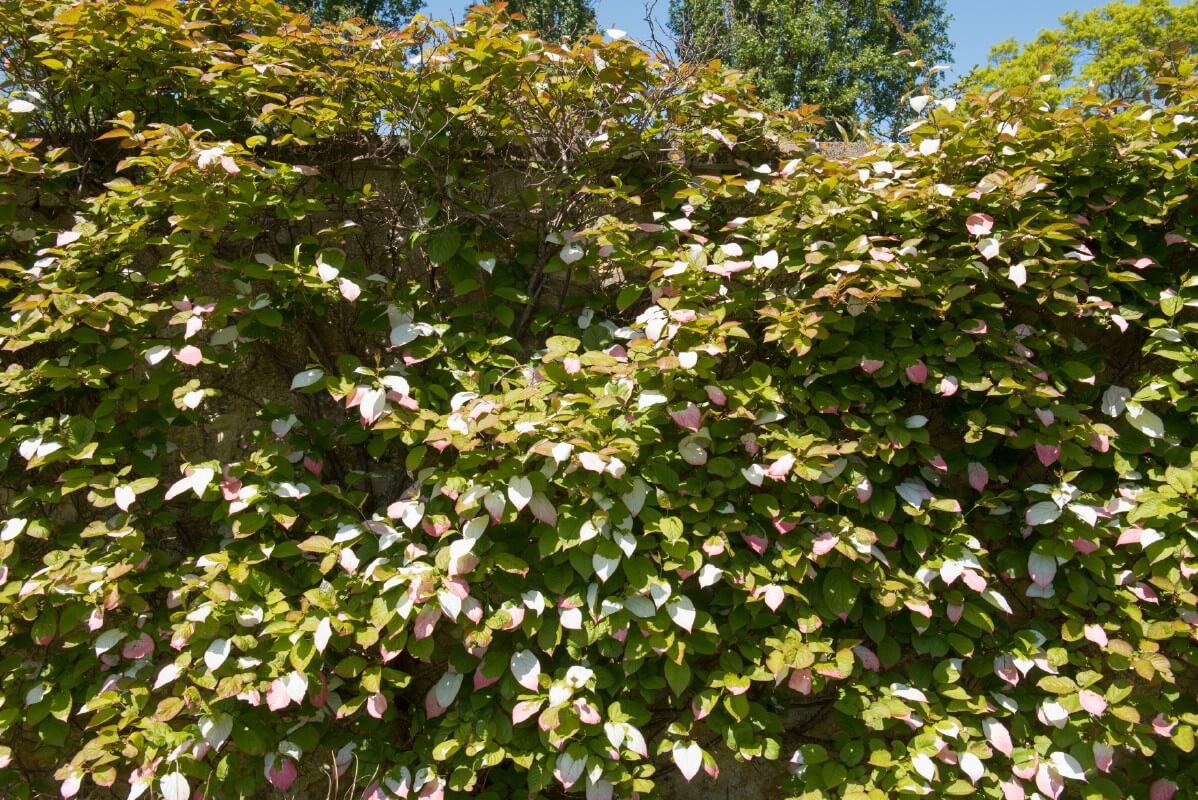
A perennial climber with flamboyant foliage and edible fruit, Variegated Kiwi is a winner in all respects. The prolific overlapping heart-shaped leaves come out all green, white and green, or with heavy pink markings. Variegated Kiwi is a true knockout! In early summer, lightly scented white flowers bloom, but they often get lost in the show of the leaves.
After the flowers bloom, Variegated Kiwi produces edible little kiwifruits. Not as big as the well-known grocery store kiwifruit but just as tasty, these kiwifruits are grape-sized, smooth, and can be eaten whole. Variegated Kiwi needs male and female plants to produce fruit. This vining perennial grows quite large, quickly reaching 15-20 feet tall and 6-10 feet wide, so only plant this if you have adequate space!
- Hardy to zones 4-8
- Full sun or partial shade
Carolina Jessamine (Gelsemium sempervirens)
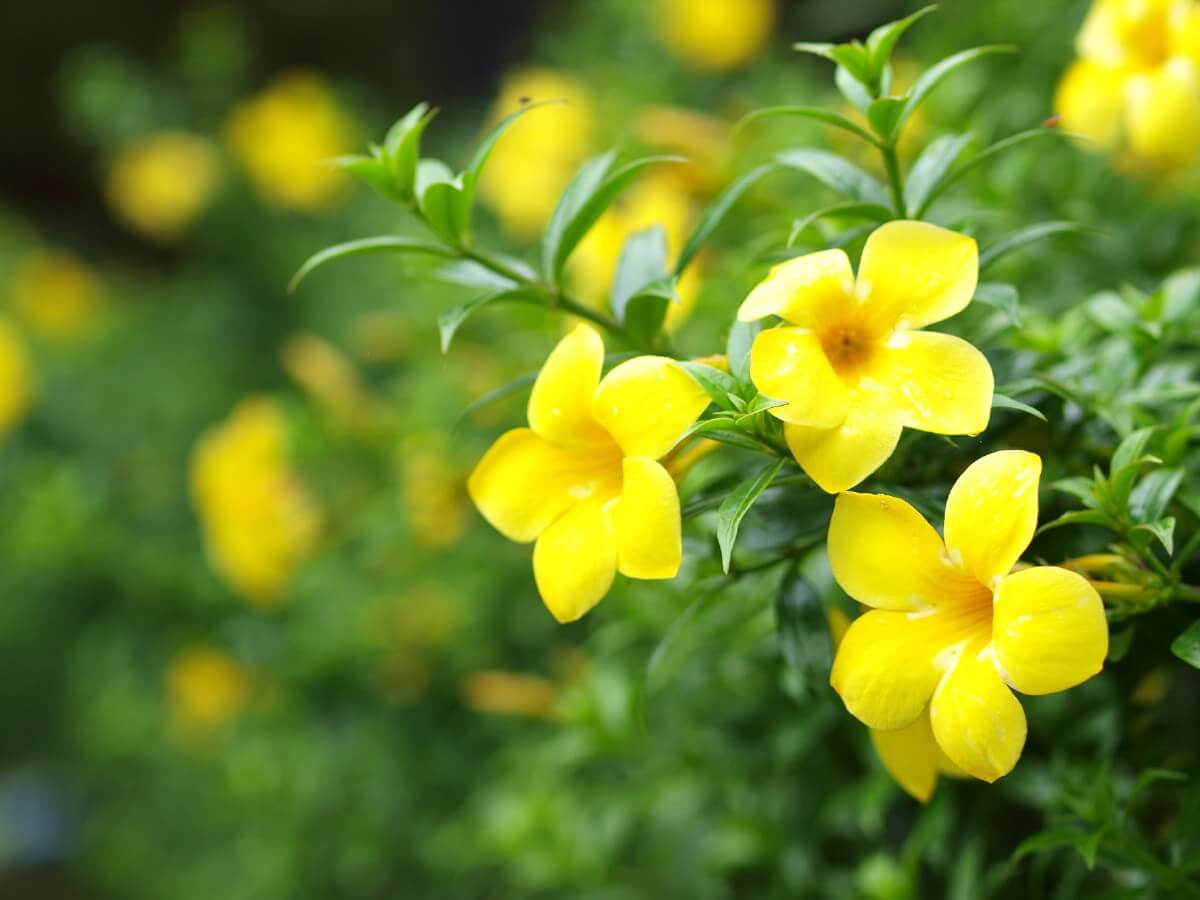
Like a bucketful of sunshine in full bloom, Carolina Jessamine wows the senses with its brilliantly colored flowers and sweet fragrance. The flowers are buttery yellow, trumpet-shaped, and bloom profusely in late winter into early spring. This is one for the warmer climates and will grow over anything, including fences, structures, and even up trees. Bees, butterflies, and hummingbirds adore the flowers and will visit in droves. Carolina Jessamine grows 10-20 feet tall and 3-6 feet wide.
- Hardy to zones 7-10
- Full sun or light shade
- Deer resistant

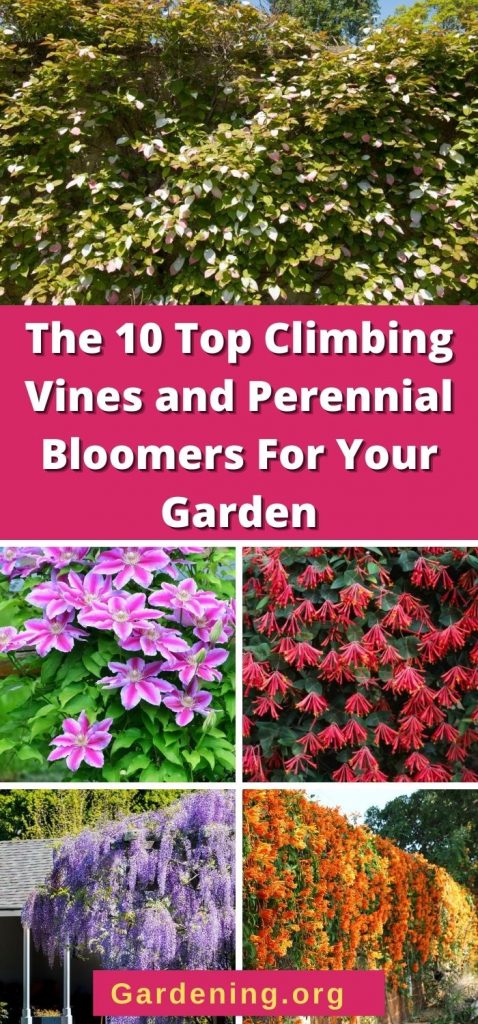
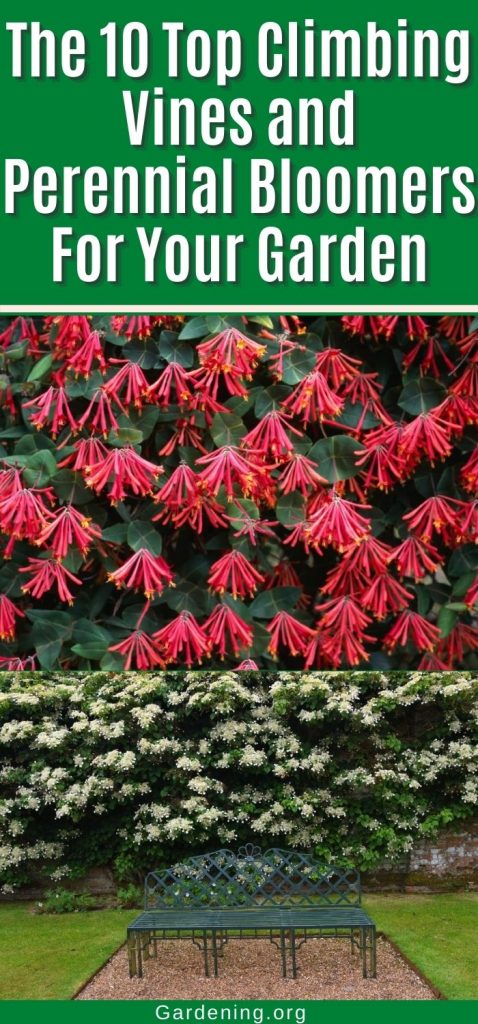
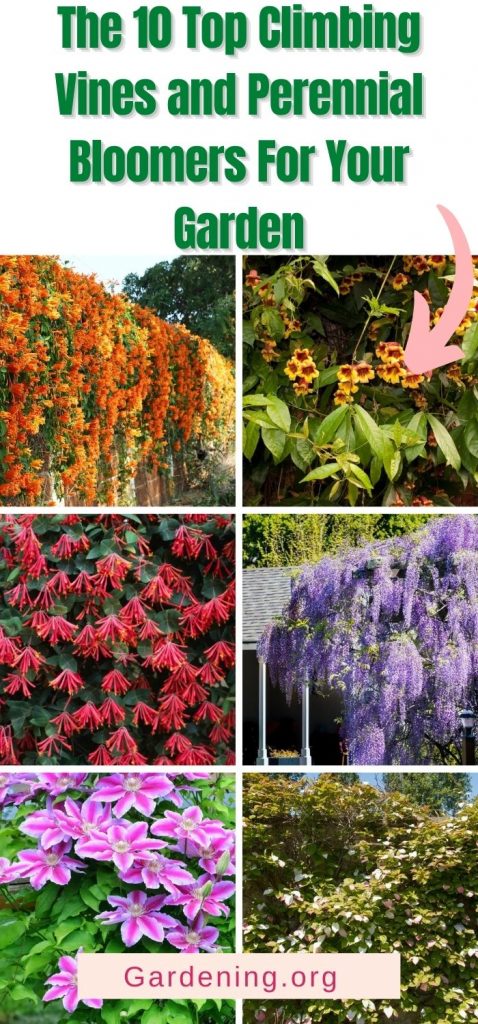
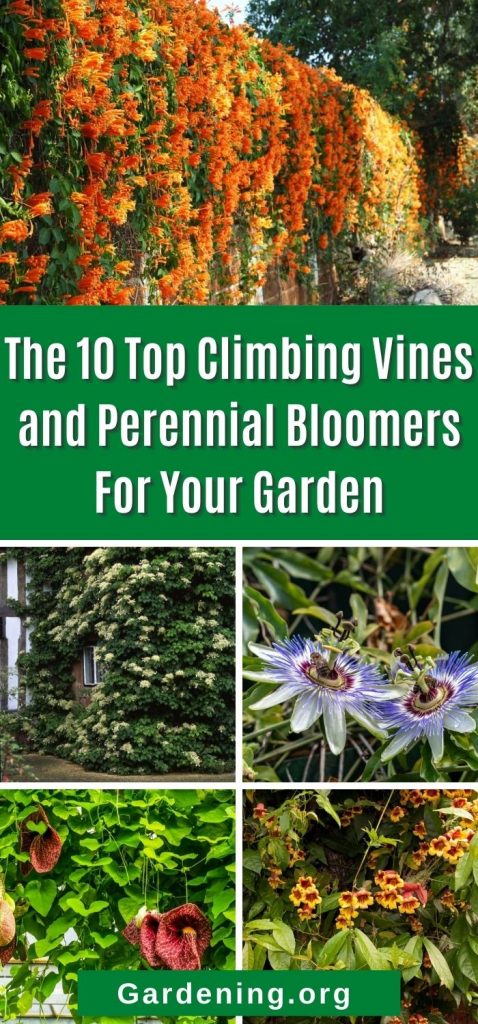

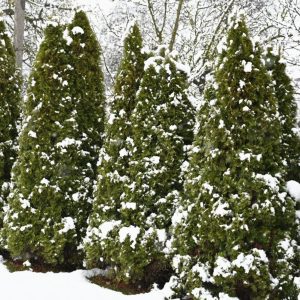


William Reilly
Please post stories about natives...some parts of this country are over ran by invasive plant species.. thanks for telling folks to plant in a pot instead of in the ground...I love trumpet vines but very invasive...
Thanks~💚